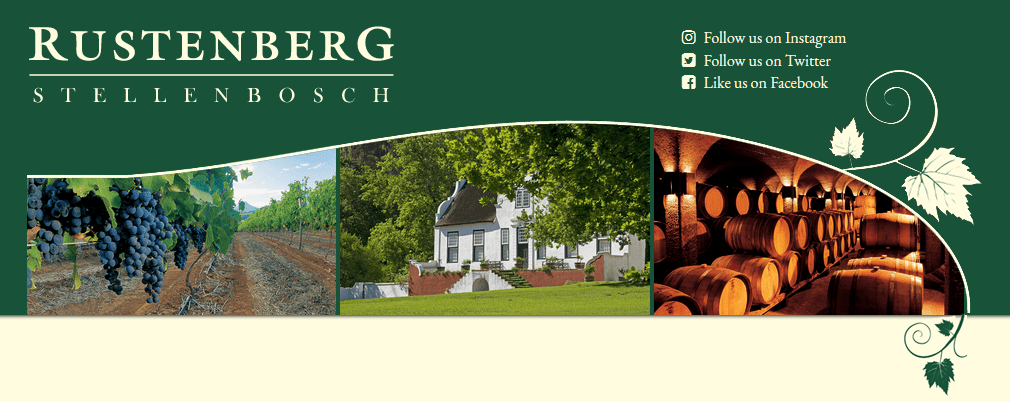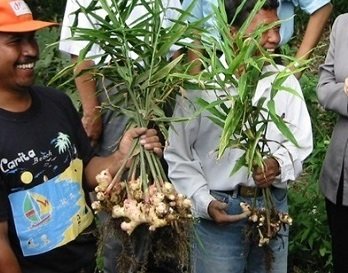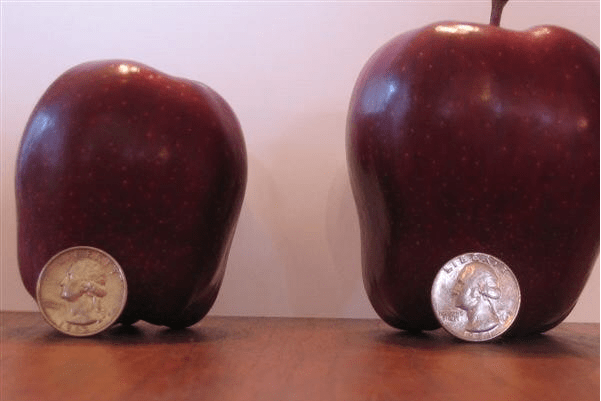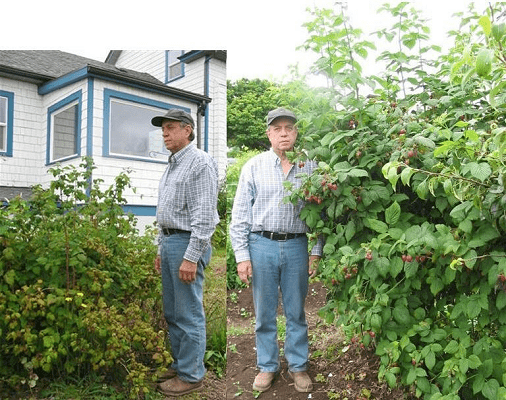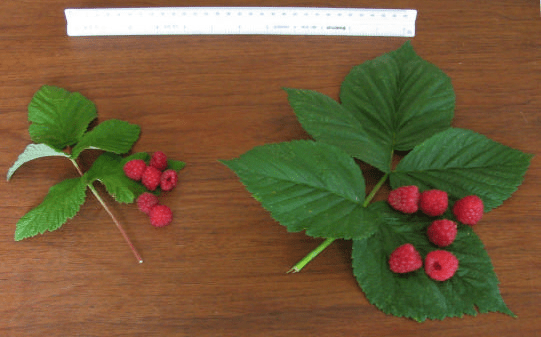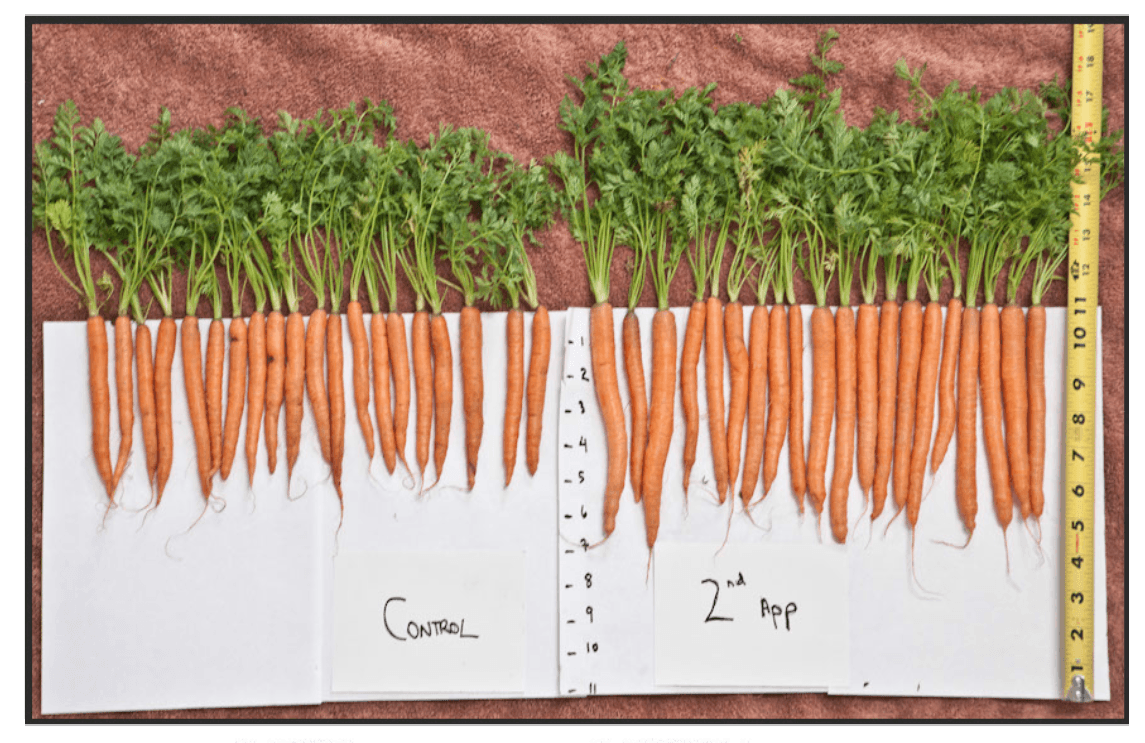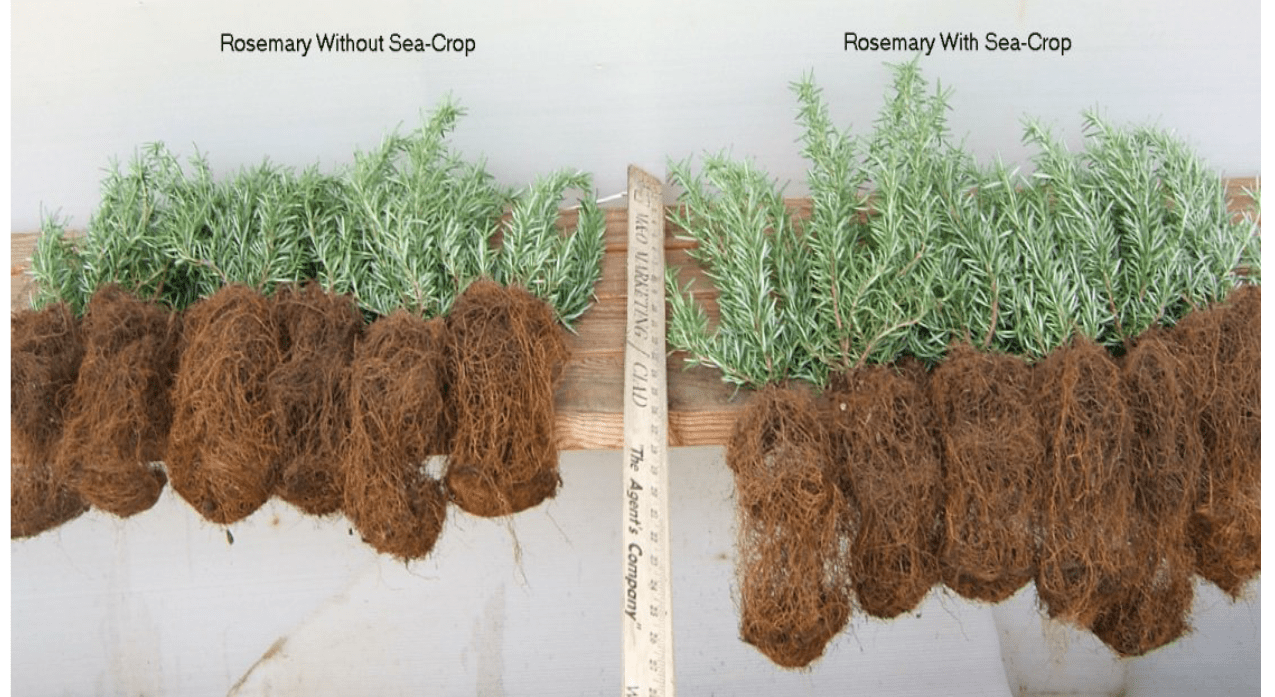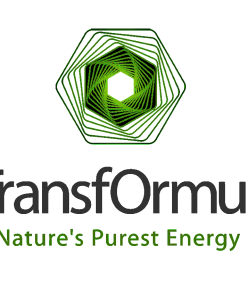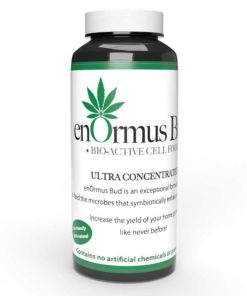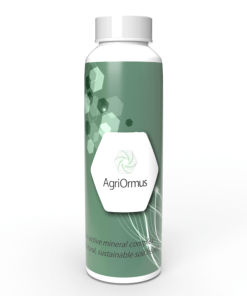Agriculture
Agricultural Ormus
Agricultural Ormus
Artificial chemicals can temporarily push yield without due consideration for the quality of the food being produced and the impact this has on human, animal and plant health; and also leads to soil degradation. Agricultural Ormus is the ideal solution to overcome the negative impact of these harsh chemicals, while increasing yield quantity and quality, building accumulated soil and plant health among the microbiome. After all, it’s the soil that we should be farming…
Agricultural Effects of ORMUS
Professor Hou Tian Zhen, the director of the Department of Tree Physiology and Biochemistry at the Xinjiang Academy of Forestry Sciences in the People’s Republic of China, led a team of researchers evaluating the use of it in three separate experiments.
In 1989, the first experiment was conducted in the greenhouse at the An-ning Experiment Station, tomatoes treated with it averaged nearly double the number of flowers per plant and 27% more fruit. Thereafter, field experiments at the An-ning Experiment Station demonstrated that the treated green beans increased yields by 81%, sweet beets yields increased 67%, and soybeans increased 29%.In 1991 a large-scale field experiment was conducted using watermelon plots 300 meters apart in a field at the An-ning Experiment Station. Treated melons yielded 65% more than the control group.
Professor Zhen noted the hypotheses that might explain the mechanism of yield increase. While some scholars suggest it might effect the wider opening of the stomata (pores in the under side of the leaf through which gases flow in and out of the plant), another explanation was given by Dr. San Lunjing, professor at Zao-Dao-Tian University in Japan. He suggested the bioelectrical potential is shafted when the plant receives the stimulation. The shaft, in turn, generates ionic flow and such ionic flow stimulates cells resulting in optimized growth.
Other than the visual characteristics of m-state or Gans nanomaterial, it also exhibits physical properties. Elements in this alternative matter state emit energy fields similar to magnetic or electromagnetic fields. Many refer to this as Magnetic and Gravitational in nature thus adopting the term MaGrav Fields. Magnetic devices has long been applied in a water softening applications, and energy emitted by m-state matter would play a roll in structuring soil locked water bodies, specifically around the areas where Ormus was applied. Research into magnetics suggests that magnetized, structured water increases crop growth rates. Structured water is softer and easier absorbed through the plant membrane. I’m of the opinion that Ormus not only helps condition moisture content around the plants but also supply n broad range of minerals which stimulating both plant and the life around it. Below are more testimonies from around the world and South Africa.
Photo Credits Subtleenergies.com and Vancouver Island Ormus
Harold Aungst, a Pennsylvania alfalfa grower using Ormus won every contest in his county for growth and nutrition, with 29% protein, the most tons per acre and five cuttings instead of three. He got 7.6 tons/Acre the first year using this technology, nearly double the state average of 3.4 tons/Acre. The second year that increased to 10 tons/Acre, triple the state average. Use of this new technology treated hay resulted in a 30% increase in milk production.
“The cows now eat up the stems and all where in other years they’d let them lay. The cow’s nose is a good barometer of how good the hay is. If you throw down this hay with hay from somebody else’s farm, I’ll guarantee they’ll pick this hay every time.”
In 1992, JoAnn Mahaffey of Stone Ground Farm in Ontario, Canada showed a 50% yield increase over controls even though the latter were close by and received the advantage of sound.
Using Ormus, John Fergusson of Orange, New South Wales, Australia obtained 160% yield increase in plums, 130% yield increase in nectarines, and 100% in apples. All were larger, had increased sugar, and a longer shelf life. Their blueberry bushes are ready for picking 10-14 days earlier than normal, and their flavour is exceptionally sweet.
Along the Sunshine Coast in Australia, an organic citrus grower showed treated plots increased yields of 300% over the control plots and achieved an earlier maturity. His first reaction? “I laughed at it.” Now? “I’ll eat my words. It really does work.”
AgriOrmus Clients
Heiner : Young farmer in Tankwa Karoo. 225% increase from one application of Ormus!
“I have just come back from the farm having harvested the first batch of Lucerne after the Ormus application. For the harvest before the Ormus application, we collected just under two trailer loads of cut Lucerne from the field (this being my standard means of measurement as I don’t have a bailer yet), then about five weeks after the Ormus application we harvested again and we collected four and a half trailer loads for that very same field. I can’t say I was too surprised but wow, it was a wonderful experience to witness. I am hoping to make Ormus part of my yearly growing routine!”
Jesse: Urban gardener.
“We used Ormus on some of the grow beds but not all. And it was amazing, Ormus really rejuvenated the plants where we used it. The vegetables grew faster but also healthier, seemed like with even brighter or deeper colours. The difference was noticeable. The team kept bugging me to get more!”
Our own research on 300 mature walnut trees shows remarkable results. We treated half with Agricultural Ormus for 2 years and these showed 25% greater branch tip growth that the untreated trees, as well as 16% advantage in trunk thickness gain over the treatment period.
Ormus is organic and entirely non-toxic. It is easy to apply by simple spraying or soil drenching.
Agriculture
Agriculture
Featured Products
Using Horticultural Ormus
Apply Horticultural Ormus to crops with a sprayer.
Soil Drenching: Dilute the product at the rate recommended on the label. Apply 2 to 3 sprays either in autumn or spring before planting begins.
Foliage: Dilute Ormus at recommended dilution in your spray bottle. Apply as a foliage spray early in the mornings….. This helps the plant fight pests and diseases from preying on the plant as a food source. Ormus interacts positively with dew. Spray either early in the morning while the foliage is still wet with dew, or in the early evening. Upper and lower leaf coverage is recommended when plants are entering their reproductive growth or when plant disease is present.
It is suggested that the sprayer’s focus and emotional state affect the performance of Ormus through a process known as quantum entanglement. In short, the sprayer is an agent acting within the loop producing plant life. Just as the sprayer’s physical actions affect the plant, her emotions and intent affect the plant, too. A caring, nurturing emotional state combined with a positive outcome will achieve the best results.
Field Trial Results
Rustenberg Wine Estate, Western Cape, Summer 2018 / 2019
This report details the results of field trials conducted on the historic Rustenberg Wine Estate in Ida’s Valley, Stellenbosch over the summer of 2018 /19. The results show that EnOrmus Bud not only increases plant volume but also plant health when compare to untreated subblocks.
To assess whether or not EnOrmus Bud improves plant growth and health, an experimental design was set up on the Merlot block. The 22 277 vines were divided into five subblocks for different treatments.
Block B in this report received agriOrmus treatment at an application rate of 10 litres of EnOrmus Bud per hectare. Block B & Block E enjoyed the largest gains per hectare.
On Block E, EnOrmus Bud was applied according to specification as a soil drench at the start of the season, on 21 September 2018, at an application rate of 10 litres of EnOrmus Bud per hectare. This was followed by a leaf spray before the budding stage, early in December 2018, at an application rate of 2 litres of EnOrmus Bud per hectare.
Significant differences were observed in plant measurements such as volume, height and normalized difference vegetation index (NDVI). When considering plants treated with EnOrmous Bud and those that are not and its relationship to the plant measurements, there is a significant difference in favour of the EnOrmus Bud.
Treating plants with EnOrmus Bud produce healthy plants.
Adding naturally-occurring ocean minerals (Ormus) back into the soil (sodium removed), results in food with higher mineral content. Ormus typically results in a 10-15 percent jump compared to foods grown in untreated soils. It’s ionic minerals; there are no plant hormones, additives, or anything. The plant will use what it needs, because it’s ionic. It only takes little microliter size of Ormus to produce millions of ions. You notice the growth effect.
Elandshoek, Aliwal North, Eastern Cape, Autumn 2016.
From autumn 2016 an experiment was conducted of the farm Elandshoek near Aliwal North, to compare EnOrmus Bud treated and untreated subblocks on mature walnut orchards. The aim was to improve the growth rate and yield of the +- 5 000 walnuts trees that were established on Elandshoek over the previous +- ten years.
Measurements were taken of trunk thickness and shoot tip growth over the following two growth seasons, and harvest data is currently being taken after the third growth season after applying EnOrmus Bud over three seasons, autumn and spring, at an application rate of 10 litres per hectare through soil drenches.
Trees in treated subblocbks gained consistently more in trunk circumference compared to untreated subblocks.
UFF Farms – Hochland, Bonathaba & Zwartfontein , Western Cape, Spring 2019.
The objective of these trials was to assess the performance of enOrmus Bud across a variety of crops, including both young and mature orchards. A key consideration for future usage is the ability of enOrmus Bud to improve growth, yields, food quality (appearance and nutrition) and the ability to reduce NKP inputs over time. It was agreed that these three farms would be ideal given their locations and the assortment of fruit grown.
Benefits
- Increased crop yields,
- Better soil micro flora,
- Improved phototropism,
- Earlier plants production,
- Improved cellular respiration,
- Improved soil tilth and aeration,
- Improved photosynthesis,
- Increased carbohydrate content of sap,
- Stronger plant resistance to insects and disease,
- More nitrogen fixing bacteria in soil,
- Increased phosphorous-leaching fungi,
- Improved drought tolerance,
- Improved transplant tolerance,
- Larger & better tasting fruit,
- Longer produce shelf life,
- Increased mineral and vitamin content.
Methodology
On each farm, a few crops were selected for trials. Applications were made in spring 2019 during September. Minimum dosages were applied as a soil drench at the rate of 2ml per plant. It is common to follow-up with a foliar spray later in the season, and this was not done.
Mixing the enOrmus Bud in a water tank. Two rows were selected for each crop for treated trials and two nearby rows for selected as the control (untreated). The farm managers were involved in selecting the locations for trials.
Application was done by hand to restrict the treatment to the experimental rows. In practice, enOrmus Bud can be applied through the irrigation system.
The field trials were designed and set-up by Charl Pienaar, who has an MSc in plant breeding. A total of 2969 trees were treated, split equally between experimental and control specimens.
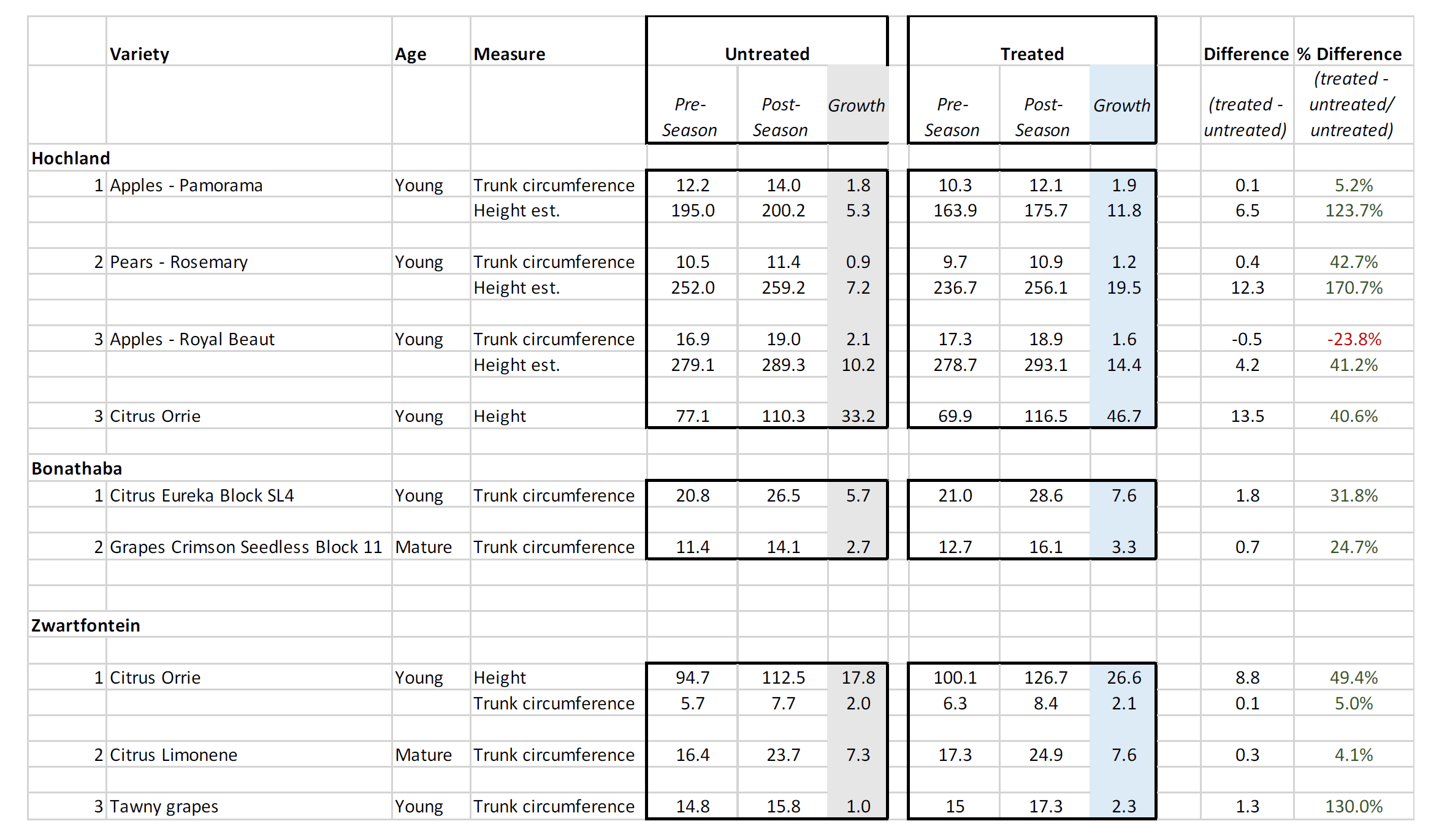 Notes:
Notes:
1. All units are cm.
2. Difference = difference in growth between treated and untreated, in cm’s. Shows incremental growth of enOrmus Bud treatment in cm.
3. % Difference = difference in cm growth as a % of untreated growth. Shows incremental growth of enOrmus Bud treatment as a % of untreated.
Discussion and conclusions
In 12 of the 13 trials, enOrmus Bud treated trees grew better than trees that were not treated. The exception is Royal Beaut apples trunk circumference, which showed only 0.5 cm less gain than the treated trees. However, Royal Beaut apples grew 4.2cm taller on average.
As expected, trees gained more on height than trunk circumference. Best performers on height were Rosemary pears (170.7%) and Pamorama apples (122.6%), which showed more than twice the gain in height than those that were not treated.
Citrus performed really well, with an average varietal height advantage gain of 45% as well as 18% better growth in trunk circumference – with some varietals doing better than others.
Relevant results from other farms
Tokara has shown an incremental increase of 1 ton per hectare on their grapes treated with enOrmus Bud.
Building on the prior year’s exceptional results at Rustenberg Wine Estate, our Ormus based products were the top performers again. This indicates that the effects are cumulative and build more advantage over time. Recall that using NVDI analysis, the Ormus treated vines showed a 9% advantage in plant health over other treatments.
We are conducting large winter field trials on wheat, canola, pastures and vegetables. These results will be available on request.
Sources
- www.diatomaceousearthonline.com.au
- www.ormus-water.com/science-behind
- www.life-enthusiast.com/articles
- www.subtleenergies.com/ormus
- www.liquidplasmafeeding.com/blogs
- www.amazon.com/Sea-Energy-Agriculture

